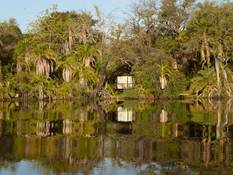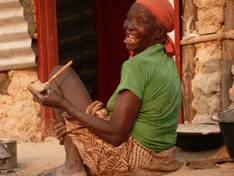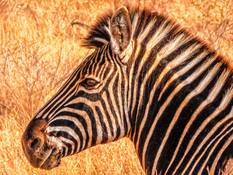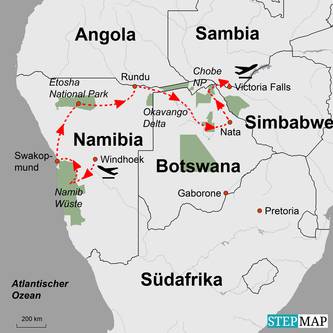Elephant herds of the Chobe River
The world's oldest desert, the wild former Caprivi Strip, the unforgettable Okavango Delta, the world's largest elephant density at Chobe National Park and the mighty Victoria Falls - a guided tour to the greatest natural wonders of Southern Africa-
Accompany us on this unique and exclusive adventure trip to great highlights of Namibia, the natural beauties of Botswana as well as the mighty Victoria Falls. The unique natural paradise of the Okavango Delta and the mighty Victoria Falls are some of the most rewarding destinations in Southern Africa. The rise of the starry sky above Makgadikgadi National Park, the wild-romantic Zambezi region and the biological diverse Chobe National Park make for a fantastic backdrop to this memorable adventure. Let yourself be inspired by the feeling of unlimited freedom, the friendliness of the people and the warm sun of Africa.
Tour Highlights
- One of Africa’s greatest safari destinations, the Etosha National Park
- The expanse of the Namib Desert
- The coastal town of Swakopmund
- The peaceful kingdom of the Kavangos
- In the footsteps of the San Bushmen on the Tsodilo hills
- The natural paradise, Okavango Delta
- The starry sky over the Makgadikgadi National park
- The animal kingdom of Africa
- The famous Chobe National Park
- A huge natural spectacle: The Victoria Falls
…and much more!!!
Itinerary
Day 1: Departure to Africa
Today your journey begins with the long-haul flight to Windhoek, Namibia.
Day 2: Welcome to Namibia
Morning arrival in Windhoek, Namibia, where you will be greeted by your English speaking tour guide. We then make our way West, to the edge of the Namib Naukluftberge. Here we come to one of the driest and most remote corners of the earth, the Namib Desert. The extent of the Namib is from the North to the South 2,000 km and it extends to 160 km into the country. The Namib is the oldest desert in the world at around 80 million years old; about 95,000 square kilometres and at the same time one of the most inhospitable places on the planet. At daytime temperatures well above 50 ° C, nighttime temperatures below 0 ° C, decades of drought and frequent sandstorms, plants and animals are exposed to extreme living conditions. Here we stay for the next two nights in a beautiful lodge on the edge of the Namib Naukluft Park. In the evening we enjoy our welcome dinner together at the lodge’s restaurant. 318 km / D
Day 3: The red dunes of the Namib Desert
Today we have to get up very early because we drive into the park at sunrise to watch the sun throw a fantastic shadow on the dunes. At sunrise, we will visit the famous dune 45, which is about 140 m high. On a walk to the Dead Vlei, where in a salt pan the dead camel thorn trees form a fantastic photo backdrop, we drive in a four-wheel vehicle, past powerful sand dunes to the actual Sossusvlei. "Sossus" means "blind river” in the language of the Nama (blind because the Tsauchab ends in nothingness). In the afternoon we visit the Tsauchab River for a an hour's walk down to the beautiful Sesriem Canyon. In the evening (optional- not included in the tour price) we can be taken on a spectacular flight over the Namib Desert. 82 km / B, D
Day 4: Through the rubble desert to the Swakopmund
In the morning we drive in a Northwesterly direction first through the rubble desert of the Namib. After two exciting passes, the Gaub and the Kuiseb Pass, we also come across the Southern tropic of Capricorn. In the afternoon the trail leads us down to the coast to Swakopmund, where the cold Atlantic meets the hot Namib Desert. After checking in at a centrally located guest house, the afternoon is free for all kinds of excursions. We will gladly help you book additional excursions, such as a Mola Mola cruise to the seal colony in Walvis Bay, or an exciting ride on quad bikes into the dunes of the Namib. If you prefer to shop and take a break from everyday life, then the old German colonial city also has much to offer. With only 44,000 inhabitants, the city centre is not crowded, but still offers interesting pedestrian passages and shops. 346 km / B, D
Day 5: Twyfelfontein
In the early morning we head Northwest to the Spitzkoppe. After a short walk along the granite cliff, the path leads us to the famous World Heritage Site of Twyfelfontein. In this area thousands of rock paintings/carvings are collected in a small space which come from Middle and Neolithic cultures and are among the oldest representations in Africa. For millennials, this place was used for rituals, from about 4,000 years ago by the hunters and gatherers, since about 2,500 years ago by the Khoikhoi. On an exciting guided tour, the lives and art of the Bushmen are brought closer to us. Built on large granite cliffs, the stylish lodge is located in solitude, with beautiful views and a refreshing pool where we will be staying for the night. 384 km / B, D
Day 6: The Etosha National Park
Today we head Northwest after breakfast to the entrance of the world famous Etosha National Park. After a short break in the village of Outjo we reach the park via the southern Andersson Gate. We will drive in a Southerly direction to our campsite . On out first game drive we may finds some of the parks 114 mammal species, 340 bird species, 110 reptile species and 16 species of amphibians. 411 km / B , D
Day 7: The Etosha pan
Today is dedicated to the famous Etosha National Park. The park is a 22,275 km ² nature reserve high in the Northern part of Namibia. Etosha National Park is the country's most important National park. It is located on the Northwest edge of the Kalahari Basin and covers almost the entire 5,000 km ² Etosha pan. The name "Etosha" comes from the Oshivambo and means "big white place". The Etosha National Park is home to a huge variety of animals. After am extensive safari drive in our vehicle, we arrive at our next lodge in the Eastern side of the park, where we can cool down in the inviting swimming pool. In addition, the lighthouse is also available for wildlife viewing in the lodge until late at night. 149 km / B, D
Day 8: In the high North of Namibia
Today we leave the park via the Eastern Namutoni Gate and the route leads us far North to Rundu, the beginning of the former Caprivi Point, today's Zambezi region. As we drive through rural areas, we will pass small settlements and the typical thatched-roof huts. The Kavangos living here are very warm and friendly. The Okavango River is the lifeline for the region and forms a 400 km long natural border between Namibia and the Republic of Angola. We will be staying in a cozy lodge for the nights, in a family atmosphere on the banks of the Okavango River, opposite the border of Angola. In the late afternoon, a short, romantic drive on the Okavango River awaits us. Tonight we will be entertained by traditional dancers and enjoy a delicious dinner together. 413 km / B,D
Day 9: Through the Bwabwata Game Reserve to Botswana
Today we make our way East to the Bwabwata Game Reserve. This nature reserve holds wide wetlands, lovely grasslands, baobab trees and dense forests. The area is home to a large number of animals, including four of the well-known "Big Five": lion, leopard, elephant and buffalo. Crocodiles and hippos as well as many waterfowl can be seen along the rivers. The marshes of the Kwando river allow large herds of elephant to cross the area (sometimes 100 animals and more!). Big game includes numerous antelope species such as Lechwe, Riedbock and Sitatunga, which can only be found here. In addition, you will find bushbuck, sable antelope, lyre antelope, blue wildebeest, impala, kudu and oryx, as well as buffalo, stopping here on their hike from the Zambezi region. Finally, there are also a number of smaller antelope and small mammal species. In addition, we may be lucky enough to see some of Namibia's wild dogs and more than 400 species of birds. In the early afternoon we cross the border from Namibia to Botswana and drive the remaining few kilometres to Shakawe, where we stay in a secluded lodge, on the banks of the Okavango. Far away from the tourist stream, we dive into the wonderful world of the upper Okavango. An exciting boat transfer takes us to the lodge, where we can spot countless native birds as well as crocodiles and hippos. 260 km / B, D
Day 10: The mystical Tsodilo hills
We drive to the nearby Tsodilo Hills, one of the Bushmen's last retreat areas and the highest peak in Botswana. Tsodilo, for example, "the rock that whispers" is an area of mystical rock formations that have survived on the Earth's surface at the age of about a billion years. The Tsodilo Hills have a similar meaning to the Bushmen as the Ayers Rock in Australia for the Aborigines. On an area of 10 km ² there is the highest concentration of rock paintings in the world. Therefore, it is called "the Louvre of the Desert" and was declared a UNESCO World Heritage Site in 2001. More than 4,500 paintings have been preserved here, conveying a picture of human life and the change in local environmental conditions over the past 10,000 years. The local population venerates the place as a place where the spirits of the ancestors reside. On a walk we enjoy an overwhelming view of seemingly endless expanses. In the afternoon we drive back to our beautiful lodge on the Okavango River. 102 km / B, D
Day 11: A drive to the Okavango Delta
After breakfast, the boat takes us back to the parking lot where our car is parked. The trip takes us South today through wide bush and steppe landscapes; Again and again we pass typical African huts. Wild animals along the road are not uncommon here. In the afternoon we finally reach the Southwestern edge of the Okavango Delta. The Okavango Delta forms one of the largest and most animal-rich wetlands in Africa.Here we leave our car in a secure car park, from where a jeep transfers to our beautiful lodge on the Guma Lagoon, a paradise for anglers, nature and bird lovers. Comfortably-equipped tents will be our home in this truly spectacular setting for the next two nights. 91 km / B, D
Day 12: Natural Paradise Okavango Delta
Today we have a day in the Okavango Delta, one of the most beautiful and varied wildlife reserves in Southern Africa. Vegetation and wildlife are of overwhelming variety. So far, about 1,300 plant species have been identified throughout the delta. In the morning we glide through the delta's waterways in a typical mokoro (carved rowing boat), as we look for wildlife with an experienced guide. The diversity of animal life in this area is unbelievable! To date, 71 species of fish, 33 amphibian species, 64 species of reptiles, 444 very rare bird species and 122 mammal species have been counted. The delta offers space for aquatic species such as hippos or Nile crocodiles, sump-living species such as Sitatunga, Lechwe, Waterbuck, but also animals that depend on water for drinking. Even species that live without water for a long time are found in the delta, like the oryx. Elephants, lions, buffaloes or even giraffes and many other animals can be seen with a little luck. B,L,D
Day 13: The starry sky above the Makgadikgadi National Park
After leaving the Okavango Delta, we head East, past the town of Maun, where we have a chance to make quick purchases. In the afternoon we arrive at Makgadikgadi National Park. The giant salt pans are considered to be the largest in the world with a size of more than 8,400 km². We will check into our beautifully located lodge. In the late afternoon we will go for a walk in this fascinating area of Botswana and admire the incredible vastness. We will walk in this area until dusk, where we will be able to experience the ghostly light the sparkling stars create. You won’t be able to experience it anywhere else! 476 km / B,D
Day 14: To Northern Botswana
This morning we head North to Kasane on the edge of Chobe National Park. The National Park was founded in 1967 as the first National Park in Botswana and has an extension of 10,566 km ². Known for its huge elephant and buffalo herds, the park was named after the Chobe River, which forms the Northern boundary of the park. The Chobe comes from Angola, called the Kuando River. We will be staying in a beautiful lodge situated right on the Chobe River. 431 km / B,D
Day 15: The wildlife of Chobe National Park
We need to get up bright and early this morning, as this will allow us to see more animal life on a morning game drive. The park is especially known for its large herds of elephants, official counts in the year 2009 yielded around 120,000! The Chobe area is home to numerous other large mammal species. Large predators consist out of lion, stain hyenas, cheetahs, leopards and wild dogs. Zebras are found in the area, as well as giraffes, hippos and warthogs. Numerous antelope species such as hartebeest, blue wildebeest, eland, kudu, sable, impala and waterbuck are also founds here. The park also has a rich birdlife. Today we use solemnly for relaxation. This afternoon, we will take a spectacular boat trip on the Chobe River, which will offer spectacular wildlife watching as we make our way into the colourful African sunset. B,D
Day 16: To the Victoria Falls in Zimbabwe
This morning, after breakfast, we enter the exciting border crossing from Kazungula to Zimbabwe. Coming through the Zambezi National Park in Zimbabwe, we will move into the legendary Victoria Falls Hotel, where we will be staying for the night with a unique view from the gardens onto the nearly 200m long and 128m high Victoria Falls Bridge. On foot we will visit the huge Victoria Falls. The incredible masses of water of the Zambezi rush here with deafening thunders over 100 m deep into a narrow ravine, dense spray rises into the sky and ensures that we get wet on our walk even in bright sunshine. The locals call the waterfall “Mosi oa Tunya" (in English "the smoke that thunders"). The name refers to the water spray, which rises from the falls up to 300 m in height and can still be seen up to 30 km away. In the immediate vicinity there is even a small rainforest on the falls due to the spray, which we will also visit on foot today. There is enough time for many photos to be taken. This afternoon we get to bid for last souvenirs at a craft fair in the small town of Victoria Falls. At a grand farewell dinner we can review this truly unique journey. 95 km / B,D
Day 17: Say Goodbye
This morning after breakfast, you can take part in a short but spectacular flight over the Victoria Falls (optional, not included in the tour price). We then drive to the Victoria Falls International Airport, where you say goodbye to your travel guide and to Southern Africa. You will catch a flight back to Windhoek and from there you will reach your connecting flight towards Europe. 25 km / B
Day 18: Arrival at home
Arrival in home country
Prices and Dates
Prices and Dates on request.
*The offer is valid for a group size of 6 - 9 participants.
* The travel price excludes general increases in transport costs and currency fluctuations.
* Prices are subject to availability of selected accommodation.
* We reserve the right to make short-term changes to the travel program.
* 30 days, last possibility of withdrawal if the minimum number of participants is not reached
Included in tour price:
- Continuous English speaking tour guide from Windhoek Airport and Victoria Falls Airport
- 15 nights in 3-4 star rated establishments.
- Meals as advertised excl. Drinks (B = breakfast, L= lunch, D = dinner)
- Rides and transfers in country-specific minibus with air conditioning
- All entrances, activities and parking fees as mentioned (except optional program points)
- Detailed travel documents
- Drinking water supply during bus rides
- EUR 5.00 per person to support the pre-school kindergarten Penguin Kidz in Betty's Bay, South Africa
- Luggage transport
Excluded in tour price:
- International flights to Windhoek, Namibia and Victoria Falls, Zimbabwe
- Visiting fees for Zimbabwe (currently USD 30 one-way)
- Visitor Tax in Botswana (currently USD 30 for a 30-day multiple-entry stay)
- Optional activities and additional services
- Travel Insurance
- Drinks, tips, and personal expenses





